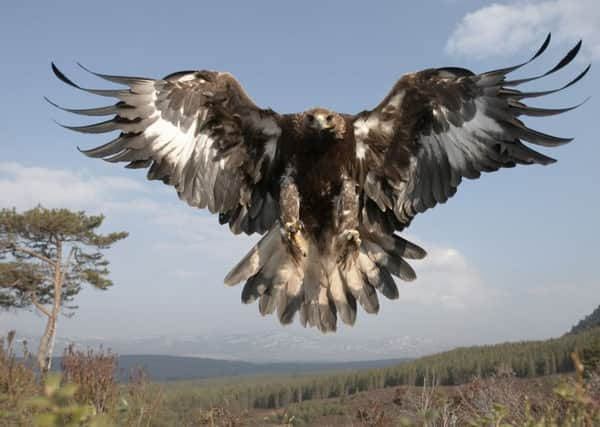Scottish national bird flying high as numbers soar


A new census, carried out last year, shows the population of golden eagles has risen by 15 per cent across the country in the past 12 years.
The count has revealed there are now 508 pairs of the iconic birds of prey north of the border, up from 442 in 2003.
Advertisement
Hide AdAdvertisement
Hide AdScotland is likely home to the entire UK population of golden eagles after the last known bird in England, a solitary male who had been resident in the Lake District since 2001, failed to appear this spring.
It is the first time since nationwide surveys began in 1982 that numbers have reached the crucial target of 500 pairs, set out by experts as the level needed to ensure survival of the species.
It’s thought Scotland has the capacity to host up to 800 pairs.
Illegal killing is remains the key threat to the predatory birds, which have a 2m wingspan and live on animals such as hares and grouse.
A total of 37 golden eagles were confirmed to be victims of wildlife crime between 1994 and 2014, with a further 11 “probable” cases.
Conservationists have welcomed the latest figures but say there is still room for improvement.
Duncan Orr-Ewing, head of species and land management for RSPB Scotland, said: “The sight of a golden eagle soaring in the sky above is an awe-inspiring part of our natural heritage, and this increase in numbers of golden eagle pairs is great news.
“Across many parts of Scotland there’s been a very welcome turnaround in how people respect these magnificent birds, part of a more enlightened public attitude towards birds of prey. “Increased monitoring and satellite tagging of eagles, as well as stronger sanctions against wildlife crime, may be serving as effective deterrents against illegal activity, therefore helping their population to increase.
Advertisement
Hide AdAdvertisement
Hide Ad“However, the continued absence of golden eagles in some areas of eastern Scotland remains a real cause for concern and suggests that much more work needs to be done.”
Golden eagles were once widespread across the UK, but had disappeared from England and Wales and declined massively in Scotland by the mid-1800s due to widespread persecution.
Part of the surviving Scottish population suffered a dramatic drop in breeding success in the 1960s due to poisoning from organochlorine pesticides, which caused mass infertility and eggshell thinning.
The northern Highlands and central spine of the country, between the Great Glen and Stirlingshire, saw the greatest rise in eagle numbers between 2003 and 2015.
Recovery also continues in much of the west Highlands and islands, where modest increases were recorded.
However, the upward trend is not consistent across Scotland.
Golden eagles continue to be absent in several parts of the eastern Highlands where evidence shows the species once existed. Many vacant territories in this area are on land managed intensively for driven grouse shooting.
In recent years four eagles fitted with satellite tags have been found illegally killed in the central and eastern Highlands.
Advertisement
Hide AdAdvertisement
Hide AdBut estate managers claim the increase in golden eagles is partly down to their efforts.
Alex Hogg, chairman of the Scottish Gamekeepers Association (SGA), says the organisation is delighted the golden eagle has reached favourable status.
“We are proud of the part our members, many of whom have had golden eagles on their ground for many years, have played in this conservation success,” he said.
“All land managers have played a significant role in this success and we are pleased the drop in wildlife crime is also reflecting the real progress which has been made; progress we are determined should continue.”
Andrew Bachell, director of policy and advice at government nature agency Scottish Natural Heritage, which part-funded the research, added: “It’s wonderful to see golden eagles reaching favourable conservation status nationally.
“These beautiful birds are such an important part of Scotland’s nature, a species which people love to see when they visit our wilder landscapes.
“It’s particularly encouraging to see greater recovery in some areas where persecution had been thought to be a major constraint in the past.
“That picture is uneven though, and we would still expect eagles to be doing better in parts of the eastern Highlands.
“We will continue to look at all the factors which may be limiting numbers, in the hope that we will see further spread of the range and increase in numbers of eagles in the future.”